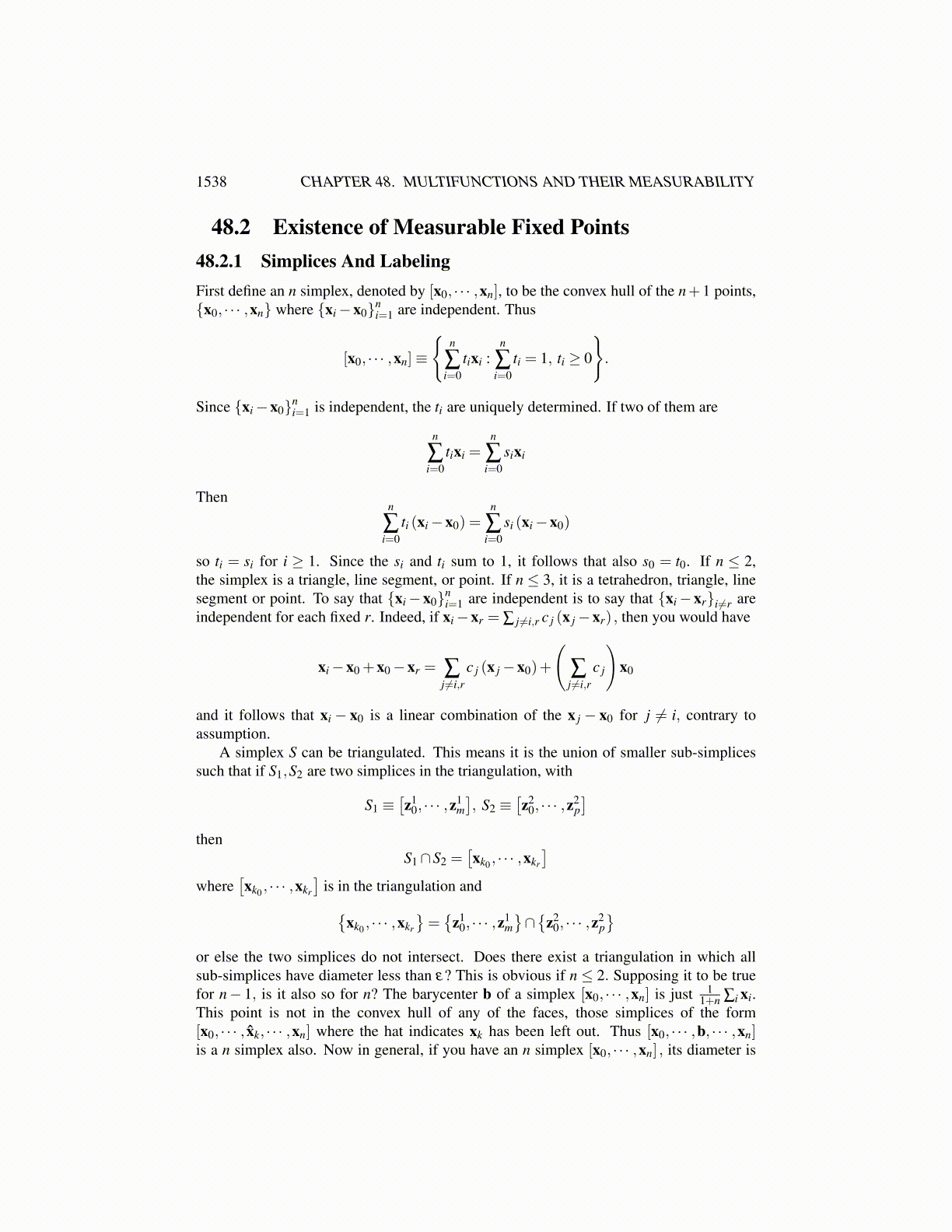
1538 CHAPTER 48. MULTIFUNCTIONS AND THEIR MEASURABILITY
Proposition 48.1.4 Let X be a Polish space and let Γ : X →P (X) have compact values.Then Γ is measurable if and only if it is strongly measurable, the latter being the statementthat Γ− (C) is measurable whenever C is closed.
Let Γ be strongly measurable. Let G be the sets G such that Γ− (G) and Γ−(GC)
areboth in C . Then clearly G is closed with respect to complements. If G ∈ G is GC? IsΓ−(GC)
and Γ−((
GC)C) in C ? I guess this is just the definition of what it means to be in
G . Also if you have {Gi} ⊆ G , Then
Γ− (∪iGi) = ∪iΓ
− (Gi) ∈ C
and so G is closed with respect to countable unions. Hence G must contain the Borel setsbecause the strong measurability implies that the closed sets and hence open sets are in G .Thus Γ− (G) ∈ C whenever G is Borel.
48.1.2 Other Measurability ConsiderationsHere are some general considerations about measurable multifunctions.
Lemma 48.1.5 Suppose f : K (ω)×Ω→ X ,K ⊆ X . Here X is Polish space, separablecomplete metric space, and (Ω,F ) is a measurable space. Also ω→K (ω) is a measurablemultifunction as in Theorem 48.1.3. Also suppose ω → f (x,ω) is measurable and x→f (x,ω) is continuous. Also suppose that K (ω) ≡ f (K (ω) ,ω). Then you can concludethat ω → K (ω) is a measurable multifunction. If K (ω) is compact, then it is alsostrongly measurable.
Proof: Let {xn (ω)} be a countable dense subset of K (ω) , each xn measurable. Thenif U is open,
{ω : K (ω)∩U ̸= /0}= ∪∞n=1 f (xn (·) , ·)−1 (U)
and each of the sets in the union is measurable. The latter claim follows from the continuityof f (·,ω) . If x(ω) is measurable, then we can express it as the limit of simple functionssn for which ω → f (sn (ω) ,ω) is clearly measurable. Then f (x(ω) ,ω) is the limit off (sn (ω) ,ω). The reason for the equality is as follows. It is clear that the right side iscontained in the left. Now if K (ω)∩U ̸= /0, then by definition, f (x,ω) ∈ U for somex ∈ K (ω) but then by continuity, f (xn (ω) ,ω) ∈U also for some xn (ω) close to x. Thusthe two sets are actually equal. Thus ω →K (ω) is measurable. If K (ω) has compactvalues it will be strongly measurable.
This lemma gives an easy example of a measurable multifunction having compact val-ues. In fact this is the one of most interest in what follows. However, we also have thefollowing general result. It gives the existence of a measurable ε net. This is formulated inBanach space because it is convenient to add. It could also be formulated in Polish spacewith a little more difficulty. One just defines things a little differently.
Proposition 48.1.6 Let ω→K (ω) be a measurable multifunction where K (ω) is a precompact set. Recall this means its closure is compact. Also, it must have an ε net for